The first Owl Tour of the year today. After gales, snow and a storm surge along the coast yesterday, the weather was much, much better today. But it was still cold in the wind which remained a rather blustery NW, and we were thankfully close to the car when a couple of wintry showers hit us during the morning. The afternoon was better, with the wind easing a bit and blue skies. Not a bad day to be out and we did very well.
After meeting in Blakeney, we had a quick drive round the back roads to see if any Barn Owls were still out hunting – or had come out to find food after a difficult night – but it was still rather too windy. A stop down by the river produced a few nice birds. A Kingfisher went zooming off over the reeds as we approached. A Cetti’s Warbler called from the dense vegetation by the water, but then showed nicely. A Siskin flew over without stopping, but a Yellowhammer dropped into the top of a tree nearby briefly.
Several small groups of Pink-footed Geese flew overhead calling, heading inland along the river valley. A short while later, we looked away to the south and saw a huge cloud of Pink-footed Geese come up from behind the trees. They had obviously been flushed from the fields, possibly from a recently harvested sugar beet field on which they had been feeding.
After the storms yesterday, coinciding with a very high spring tide, the coastal marshes between Cley and Kelling had been flooded overnight. We drove over the back roads and walked down to the coast road at Salthouse. It was a sorry sight. The road itself, the main A149, was completely underwater. All the grazing marshes between the coast road and the beach were flooded – to all intents and purposes, they looked like the sea. We could see the top of the shingle ridge and some big waves still beyond.
 Salthouse – the coast road underwater and the flooded grazing marshes
Salthouse – the coast road underwater and the flooded grazing marshes
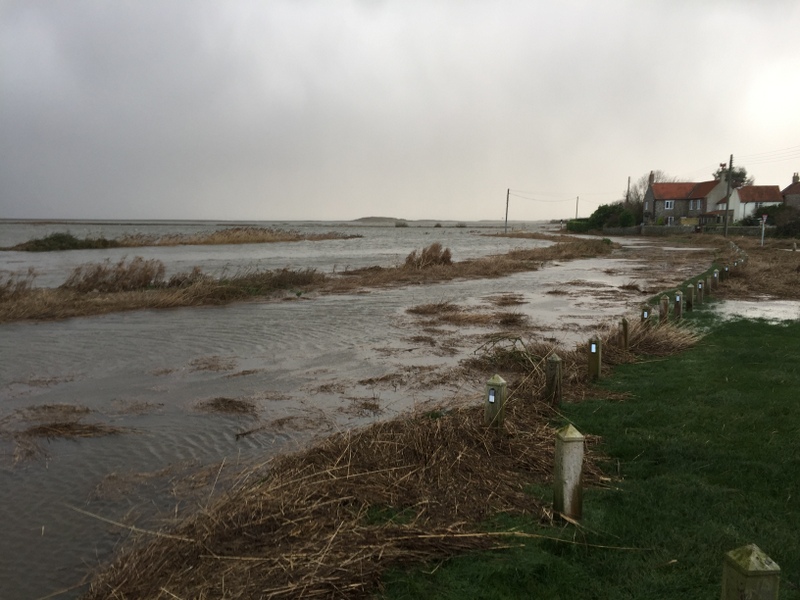 Salthouse – looking E along the flooded coast road from the village green
Salthouse – looking E along the flooded coast road from the village green
The houses in the village seemed to have escaped any damage but most of the avian residents of the marshes had been rendered homeless. We could hear Bearded Tits calling from a flooded patch of brambles the other side of the ‘road’ and looked over to see seven of them climb up to the top. They should be out in the middle of the reedbed, but the reedbed was underwater and they were desperately searching for anywhere to hide. They flew up calling, over the water, but quickly dropped back again into the garden of the pub.
A Common Snipe flew in across the water and tried to land in the strip of vegetation which would have been the far verge of the road. But it struggled to find any dry land there and it quickly flew on west. Presumably it had been spending the winter out on the grazing marshes before the flood.
Looking up, a drake Goosander flew low over the village towards us and then disappeared off west towards Cley. There have been a few on the move in the last day or so, presumably birds moving off the continent in response to colder weather, to spend the rest of the winter here. At that point, a squally shower blew in from the sea and we beat a quick retreat, back to the car.
Heading back west, we drove out of the clouds and started looking for owls again. The weather didn’t seem particularly conducive – even though it wasn’t raining, it was still windy and cold. However, at one of our regular sites we struck gold. We very quickly found a rather distant Little Owl, sheltering under the roof on a distant farm building. Nearby, a second Little Owl was doing the same. We had a look at them through the scope, and thought that might be the best of it.
We drove a little further along, and found a third Little Owl. It had found a sheltered spot out of the wind and facing into the morning sun, and was presumably trying to warm itself up. It was facing us and we could see its head pattern this time. Turning behind us, a fourth Little Owl appeared. This was was much closer and, though tucked in tight under the roof of one of the sheds, we got a good look at it through the scope. Amazing – four Little Owls out on such an unpromising day!
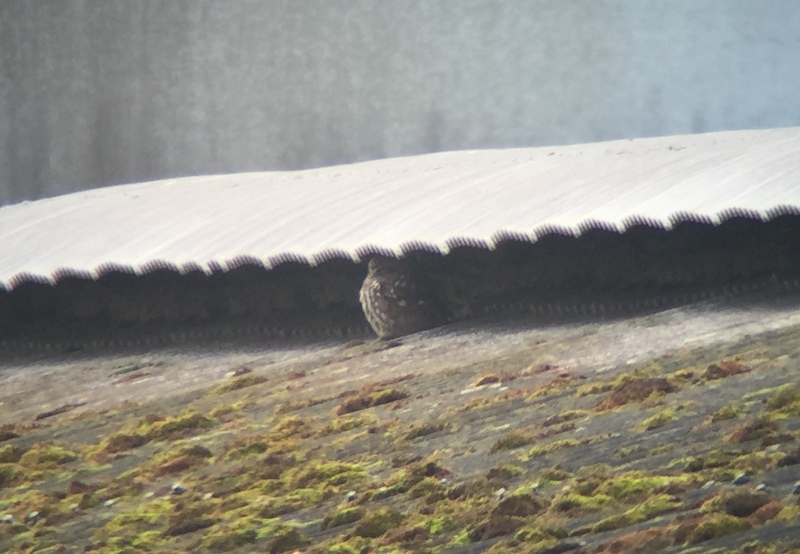 Little Owl – sheltered under the roof, facing into the morning sun
Little Owl – sheltered under the roof, facing into the morning sun
There were other birds around the farmland while we were watching the various Little Owls. A stubble field held a large flock of Curlew, which flew round periodically. A Redpoll flew out of the trees when we pulled up, and disappeared back away from us calling. A Common Buzzard came out of the wood and started to fly across the fields before thinking better of it and returning whence it came. At that point, another wintry shower blew in from the coast, and again we sought shelter in the car.
The skies looked clear further west along the coast, so we decided to head that way and try to escape the squalls. It was the right decision – that was the last shower we saw today. Drove along the coast to Titchwell, where we would also have the benefit of hides.
We had a quick look at the feeders by the visitor centre. The normal finches, Chaffinch, Greenfinch and Goldfinch, plus a selection of tits, were coming in to feed. We had limited time here today, so we pressed on. Scanning the ditches either side of the main path, a Water Rail showed briefly in the water at the bottom on one side before disappearing back into deeper cover. Rather than wait for it to reappear, we decided to have another look on the way back.
The Thornham grazing marsh ‘pool’, which has been dry for the last year or so, was flooded again, but this time with seawater which had come in through the open sluice. Consequently, there was no sign of any Water Pipits and no other birds of note. A lone Tufted Duck was diving out on the reedbed pool. Three Marsh Harriers were circling out over the main reedbed.
Island Hide provided some welcome shelter from the cold wind. The Freshmarsh is flooded at the moment, but not with seawater. Reserve staff have raised the levels of fresh water on here to kill the vegetation on the islands, and consequently there was very little dry land to be seen. It is to the liking of the ducks – there were plenty of Teal, Shoveler and Mallard, plus a few Wigeon and Shelduck. The flocks of Brent Geese frequently fly in from wherever they are feeding for a wash and preen.
 Teal – a smart drake, enjoying all the water on the Freshmarsh
Teal – a smart drake, enjoying all the water on the Freshmarsh
With all the water on here, there are rather few waders on the Freshmarsh at the moment. We did find a few around one of the only remaining small patches of island. About half a dozen Avocets were asleep, along with various ducks which were also trying to find somewhere to roost. In amongst the duck’s feet, we found a couple of Knot and a small group Dunlin too. There were lots of gulls, mostly Black-headed and Common Gulls, bobbing about on the water, taking shelter from the wind.
Round at Parrinder Hide, we had a different view of the Freshmarsh. From here, we picked up a few Pintail. A drake was preening on one of the islands, but promptly went to sleep. A pair of Pintail out on the water were more obliging and through the scope we could see the drake’s long pin-shaped central tail. The largest, fenced off island was packed with roosting Teal but around the flooded vegetation on the near side we managed to find a single Ruff.
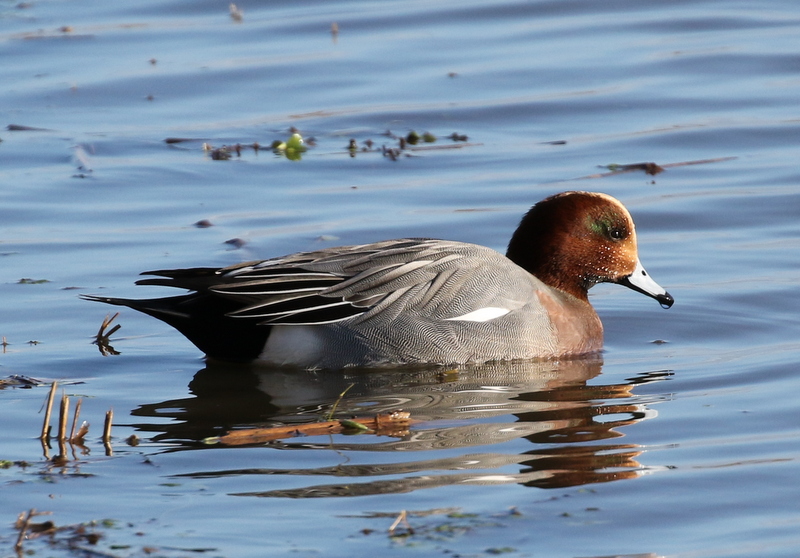 Wigeon – quite a few on the Freshmarsh, this one in front of Parrinder Hide
Wigeon – quite a few on the Freshmarsh, this one in front of Parrinder Hide
One of the group spotted a small bird making its way towards us along the edge of the bank. It was a Water Pipit – we could see its clean whitish underparts, neatly streaked with black on the breast. We were just hoping it would come right down towards the hide when it flew off.
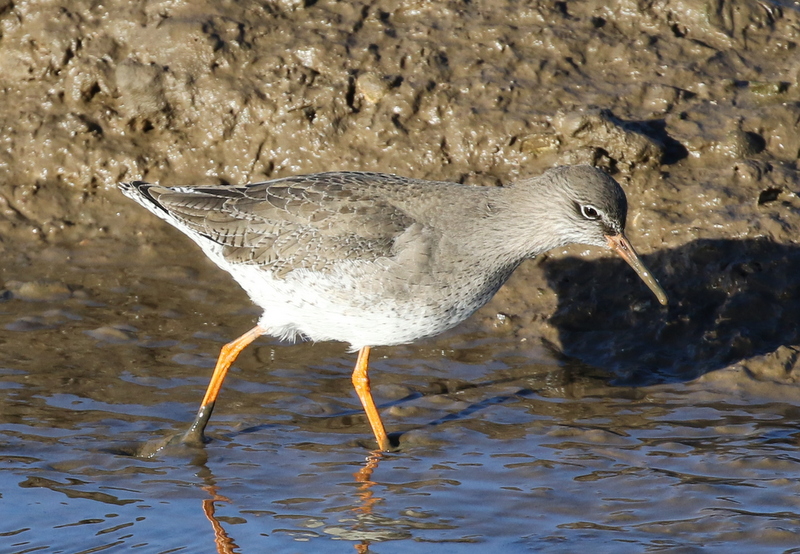 Redshank – feeding on the Volunteer Marsh from Parrinder Hide
Redshank – feeding on the Volunteer Marsh from Parrinder Hide
From the other side of the hide, overlooking the Volunteer Marsh, we could see quite a few waders. A Redshank was feeding just below the hide, its orange-red legs shining in the winter sunshine. There was also a Lapwing out just in front, and it too was looking particularly resplendent in the light, its green upperparts iridescent. Further over, we could see a little group of Knot, a couple of Ringed Plover, a Grey Plover and a single Black-tailed Godwit.
 Lapwing – showing off its glossy green upperparts to perfection
Lapwing – showing off its glossy green upperparts to perfection
Having warmed up in the hides, we decided to brave the conditions again and make a bid for the beach. On the way, we stopped to look at the tidal pools. A pair of Goldeneye were diving in the deeper water, catching small crabs. We got the male in the scope, looking particularly smart. There were several Little Grebes as well, also diving constantly. A pair of Gadwall were easier to see. But with the water level on here still high after the big tide, and with low tide out on the beach, there were fewer waders than normal.
 Goldeneye – a smart drake, showing off his bright yellow eye
Goldeneye – a smart drake, showing off his bright yellow eye
Out at the sea, the storms of yesterday had left large quatities of shellfish wrecked on the beach. A huge number of gulls had flown in to take advantage. There were quite a few waders on the beach too, particularly Sanderling and Oysterdatchers. Scanning the sea, we could see a large raft of Common Scoter out on the water but they were a long way offshore today. Still with a brisk north-west wind bringing cold air straight in from the arctic, we didn’t stay long out here, but headed back for lunch.
On the way back past the Volunteer Marsh, there were a few waders now close to the main path. A nice Bar-tailed Godwit was feeding out on the mud. We could see its shortish legs, slightly upturned bill and black-streaked upperparts. Two dumpy grey Knot were picking their way along the muddy slope just beyond the channel, and a single Ringed Plover was running around on the open mud nearby. Further over, a Grey Plover was feeding with another Knot.
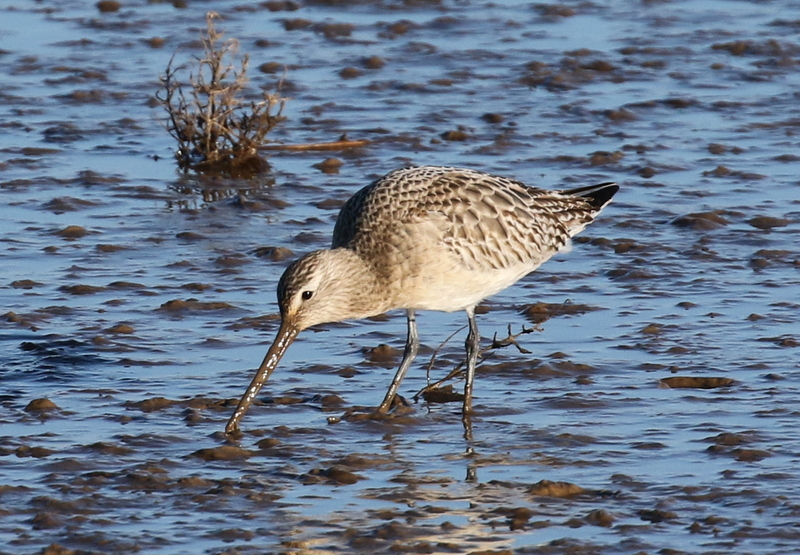 Bar-tailed Godwit – showing well on the Volunteer Marsh on the walk back
Bar-tailed Godwit – showing well on the Volunteer Marsh on the walk back
Almost back to the visitor centre, we found the Water Rail showing much better, now feeding out on the open mud in the ditch. We stopped to watch it for a while and got fill the frame views of it in the scope as it dug around in the mud with its long red bill. It was then back to the car for a late lunch.
 Water Rail – showed very well out in the open on the walk back
Water Rail – showed very well out in the open on the walk back
After lunch, we left Titchwell and started to make our way back along the coast road. We stopped at Brancaster Staithe briefly, to see if there was anything of note in the harbour. There were a few waders. Several Turnstones were picking around the stones in the car park, between the cars. Further over, a little group of Oystercatchers and Bar-tailed Godwits was roosting on the edge of the water. Another Bar-tailed Godwit and two Black-tailed Godwits were feeding in a muddy channel as we turned to leave.
It was still perhaps a little bit early for Barn Owls as we drove back, but we kept our eyes peeled nonetheless. Two white shapes out on the grazing marsh at Holkham were way too big to be owls but, with a good idea what they were we stopped for a look. Sure enough, they were two Great White Egrets. We had a good look at them through the scope, one standing next to a Grey Heron providing a great size comparison – the Great White Egret was slightly bigger!
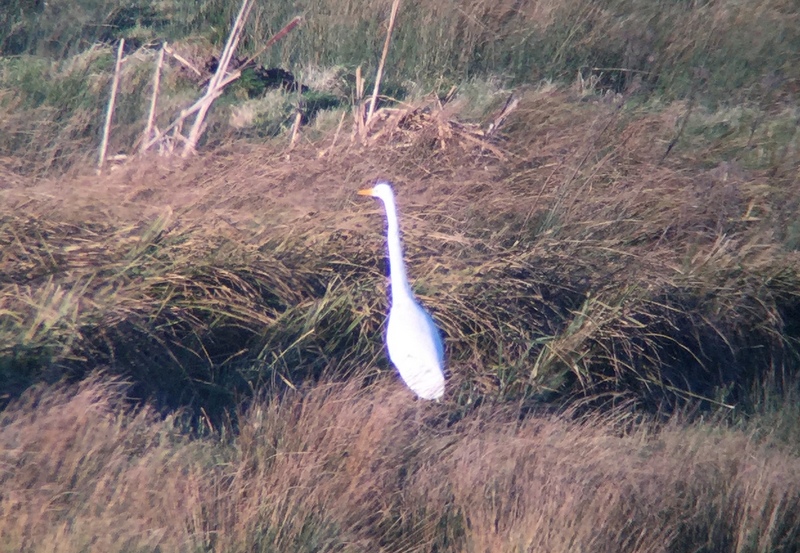 Great White Egret – one of two out at Holkham this afternoon
Great White Egret – one of two out at Holkham this afternoon
There were also lots of geese out on the grazing marshes. Scanning across, we could see a good smattering of White-fronted Geese. Three were feeding closer to us, so we got them in the scope, noting the white surround to the bill base and the black belly bars. There were loads of Pink-footed Geese further over out on the grass too, thousands and thousands of them. The Pink-footed Geese normally roost on the marshes at night and spend the days feeding in the fields inland, but around the time of the full moon that reverses and they roost by day and feed inland by night. As we stood scanning the marshes, a steady succession of flocks of Pink-footed Geese took off and flew up and over our heads.
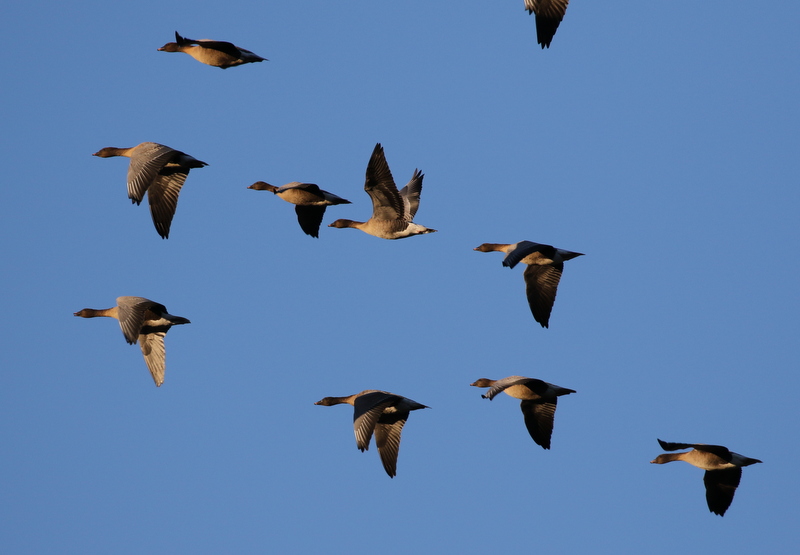 Pink-footed Geese – flying inland to feed after day-roosting on the grazing marshes
Pink-footed Geese – flying inland to feed after day-roosting on the grazing marshes
As we carried on our way east, it was getting into prime time for Barn Owls now. However, we found nothing along the coast road as we drove beyond Holkham. Perhaps it was still rather exposed here, cold and windy, so we turned inland. We were heading for an old barn where which we know Barn Owls inhabit. We hadn’t even reached it, when a Barn Owl flew up from the grass on the verge beside the car. We slowed and the Barn Owl caught us up and flew along beside the car, before crossing over the road in front of us.
It was a great view from the car, but we really wanted to get a Barn Owl in the scope. We tried to follow it, but it then gave us the runaround for a while, disappearing off across a field, cutting back, then flying back behind us as we stopped. Finally it landed in a tree beside the road. We stopped a suitable distance back and all managed to get a good look at it in the scope before it was off again, resuming its hunting.
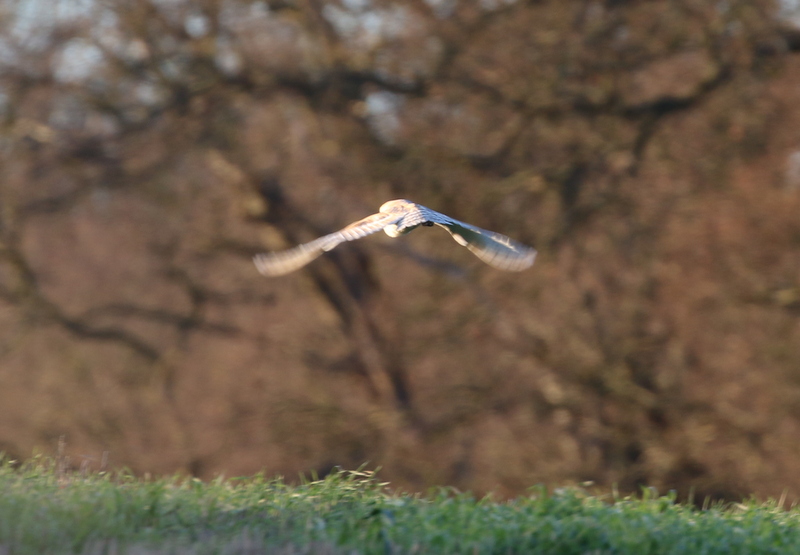 Barn Owl – our first of the day gave us a bit of a runaround for a while!
Barn Owl – our first of the day gave us a bit of a runaround for a while!
We drove on the other way and after only a short distance one of the group spotted another Barn Owl in a tree by the road. We reversed back and it sat looking at us for a just a couple of seconds before it flew off. We passed by another Little Owl site, but there were no sign of any here, there favoured perch visible from the road now not in the afternoon sun. Worryingly, there are now planning notices here, yet another barn nesting site for Little Owls scheduled for conversion into holiday cottages. Soon there will be none left! A covey of Grey Partridges in the field nearby were nice though.
As we were making our way back, another Barn Owl appeared, perched on a post by the road, our third of the afternoon. With another car behind us and nowhere to stop, we had to drive on and turn round. Thankfully, when we got back it was still on its post. We parked in a gateway some distance away and watched it for a while through the scope. It had probably found a sheltered spot, out of the wind, and was staring at the ground below looking for voles. Then, with no cars coming, we drove down along the road and pulled up alongside for some close ups. Great views!
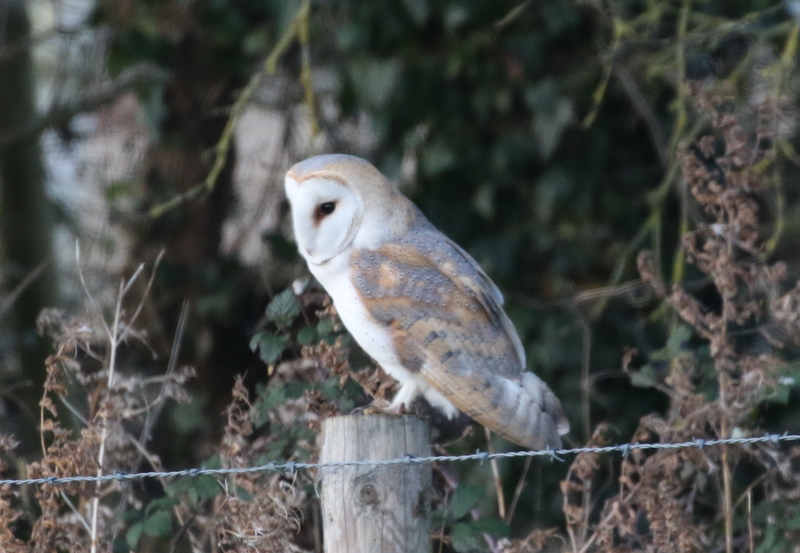 Barn Owl – our third of the afternoon gave cracking views on a post by the road
Barn Owl – our third of the afternoon gave cracking views on a post by the road
It was getting late now. We had a quick drive round via one of the meadows where we know a Barn Owl likes to hunt, but there was no sign. It was time to head round to look for Tawny Owls. We walked down and got into position, but strangely there was no hooting to be heard as we did so. The Tawny Owl came out of its roost site on cue, but annoyingly rather than fly out into the trees, it dropped straight out of the roost and disappeared back into the wood. Eventually, we could hear one Tawny Owl distantly hooting behind us. The male we had seen gave a quick burst of half-hearted hooting in front of us and then went quiet again.
The Tawny Owls were oddly subdued this evening. The wind was catching the tops of the trees, or perhaps they had been disturbed by last nights storm. It was getting dark now so we decided to call it a day. Still, it had been a remarkably successful one considering the weather.
















